#nazarbayev
Photo

नमस्ते!
你好!
안녕하세요!
Здравствуйте!
Aloha!
வணக்கம்!
Greetings from my AAPI kids, Kavi (with “Namaste” in Hindi), Ivy (”ni hao” in simplified Chinese), Paul (”Annyeong Haseyo” in Korean), Annika (”zdravstvuyte” in Russian), Kaile’a (”aloha” in Hawaiian) and Indi (”Vanakkam” in Tamil).
#american girl#my dolls#ivy ling#kavi sharma#Annika Nazarbayev#paul park#Indi Chandrasekar#kaile'a kahale#ag#agig#ag dolls#American Girl dolls#aapi#dolls of color
89 notes
·
View notes
Text
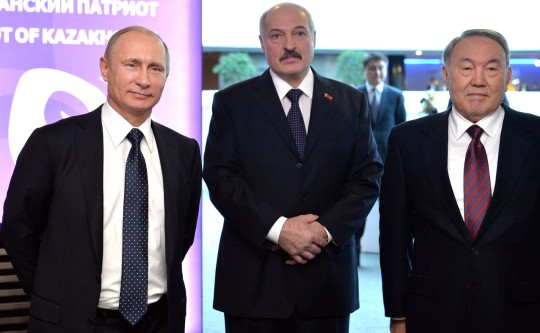
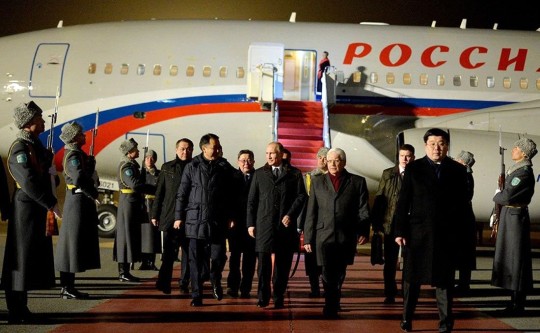

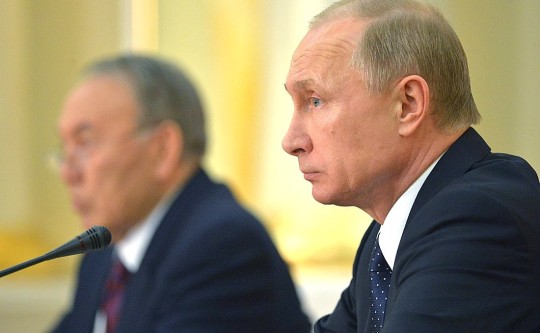





Vladimir Putin met with President of Kazakhstan Nursultan Nazarbayev in Astana to discuss development prospects for bilateral relations, the global economic situation and international affairs. After that the presidents of Russia, Belarus and Kazakhstan held a trilateral meeting. Vladimir Putin, Alexander Lukashenko and Nursultan Nazarbayev discussed trade and economic cooperation between the three countries, developing the Eurasian integration process in the context of current global economic trends and their impact, and the situation in Ukraine. The three presidents made press statements following their talks. Later, Mr Putin, Mr Lukashenko and Mr Nazarbayev visited the First President of Kazakhstan Library. March 19 − 20, 2015
#belarus#russia#Kazakhstan#vladimir vladimirovich putin#vladdy daddy#alexander lukashenko#Nursultan Nazarbayev
4 notes
·
View notes
Text
"Uwe uwe I hate biden but I hate trump even more" how about voting a third party. How about calling the office and saying why exactly you aren't voting for biden. That's like the least you can do if you're an american with a right to vote
#later tonight#my parents in kz always voted third parties they fucking hated nazarbayev#it didn't make a dent since everything was rigged but it mattered to them personally
4 notes
·
View notes
Text
"Andrew and Fergie continuously find themselves rubbing shoulders with a cast of sketchy characters."
#royalty is not celebrity#prince andrew#fergie#sarah ferguson#ghislane maxwell#jeffrey epstein#peter nygard#tarek kaituni#colonel Gaddafi#selman turk#Timur Kulibayev#Nursultan Nazarbayev#goga ashkenazi#Ilham Aliyev#merch your royalty#using your office for personal gain#trammell crow jr
12 notes
·
View notes
Text
NAUUURRRRRRRR A TURKIC LANG ACC LISTED ELBASI AS A SYNONYM OF PRESIDENT IN QAZAQ HAHAHAHAHAHAHAHAHAH
#for context that's a title nazarbayev made up for himself 😭 so it means 'leader of the country'. but we don't say it to mean president#it's literally used exclusively for him pls jm beggijh you#personal
2 notes
·
View notes
Video
youtube
Kazakhstan Top University IQ Test #shorts #shortsfeed #iqtest #trivia #q...
#youtube#Nazarbayev University Al-Farabi Kazakh National University LN Gumilyov Eurasian National University Kazakh National Technical University Sat
0 notes
Text
ALMATI’DAN FÜTÜRİSTİK ŞEHİR ASTANA’YA KAZAK BAŞKENTİNİN SERÜVENİ | MESELE
1998 yılıydı… Kazakistan Cumhuriyeti’nin ilk cumhurbaşkanı olan Nursultan Nazarbayev, ülkenin başkentini 70 yıldır başkent olan Almatı’dan Astana’ya taşımıştı. Peki, neden? Nazarbayev, başkenti Astana’ya taşıyıp burada fütüristik bir şehir inşa ederek neyi amaçlıyordu? Bu başkent değişikliği Kazak içişlerine nasıl etki etmişti? Gelin videonun devamında hep beraber öğrenelim.
(intro)
…

View On WordPress
#almatıdan astanaya#almatıdan astanaya kazak başkenti#astana#astana başkent#astana fütüristik şehir#astananın adı neden değişti#fütüristik şehir astana#kazakistan#kazakistan başkenti#kazakistan başkentinin adı neden değişti#kazakistan neden başkentini değiştirdi#kazakistanın başkenti neden almatıdan astanaya taşındı#kazakistanın başkenti neden taşındı#nursultan nazarbayev neden kazakistanın başkentini değiştirdi#nursultanın adı neden değişti
0 notes
Text

#rafael nadal#jo-wilfried tsonga#nursultan nazarbayev#astana#mirrors#hoodies#suits#ties#handshakes#reaction faces
0 notes
Text
12/16/11: The Truth About What Happened in Zhanaozen
12/16/11: The Truth About What Happened in Zhanaozen
Eleven years ago, on December 16, 2011, the bloodiest page in the history of independent Kazakhstan was written. A months-long strike by oil workers in Zhanaozen ended when police shot the unarmed strikers in the city’s central square. For another three days, the police and the army terrorized the local population.
In this documentary film, Just Journalism has reconstructed the chronology of…

View On WordPress
#documentary film#Kazakhstan#KazMunayGaz#Lukpan Akhmedyarov#Nursultan Nazarbayev#oil workers#Ozenmunaigaz#Raul Uporov#Zhanaozen#Zhanaozen massacre
0 notes
Text

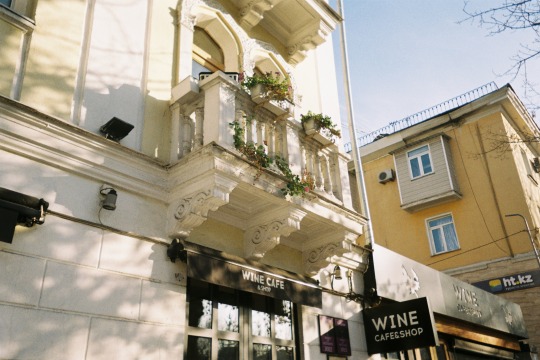
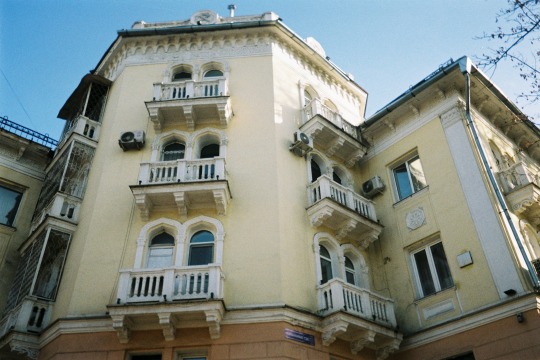


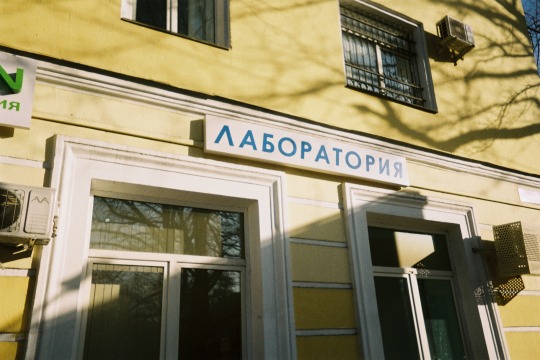
nazarbayev prospect & karasai batyr street // almaty, qazaqstan // october 2023
shot on kodak gold 200 with kodak kb-10
#got into film in kz#thought i would share some of my pics!#film photography#almaty#kazakhstan#qazaqstan#35mm film#35mm photography#tal.png
37 notes
·
View notes
Text
I made a(nother) dress

Someone posted about wanting to see a Rosh Hashanah dress with pomegranates, so here is my first version. I realize the holiday isn’t until September, but I have to sew with the muse strikes or it will never get done.

I will post more seasonally appropriate pics, but for now, please enjoy Annika playing in the very tall (to her) grass.

Finding a print that was neither ugly nor completely inappropriate for doll scale was a challenge, but I really like this one.
A few outtakes:

Supervising kitties were not happy they weren’t the center of attention.


14 notes
·
View notes
Text
Over the past month, the public in Kazakhstan has been closely following the jury trial of Kuandyk Bishimbayev, who was accused of brutally beating and killing his wife, Saltanat Nukenova. While formally the trial was about domestic violence, it captivated the public and mobilized many sectors of society due to its political significance.
The trial found Bishimbayev, a former Kazakh finance minister, who was previously convicted of bribery and embezzlement, guilty of torturing and murdering Nukenova. Bishimbayev was sentenced to 24 years in prison, while his accomplice and family member Bakhytzhan Baizhanov received four years behind bars.
Broadcast live, the trial sparked intense public discussions across generations, regardless of social class or political allegiances. Since the early 2010s, Kazakhstan’s activists have increasingly relied on social media to bridge vast distances across the country. Dozens of influencer accounts meticulously analyzed witness testimonies and the accused’s responses to prosecutor questioning.
Kazakh diaspora activists and international feminist groups held protests in London, Berlin, Warsaw, New York, and Riga. The guilty verdict is being celebrated internationally as well. “The kids in my neighborhood run around screaming ‘24!’, ‘24!’ First, I didn’t understand and then I got it,” one political activist in Bishkek, Kyrgyzstan, wrote.
The trial is a pivotal moment in transforming the public view of violence against women across Kazakhstan. More women, including spouses of government officials, came out publicly with stories of domestic violence. At least in one such case, which concerned Saken Mamash, a Kazakh diplomat in the United Arab Emirates, a criminal investigation was launched into allegations of torture that could lead to years of imprisonment.
The public is closely watching the unfolding of this case and focusing attention on reports of police refusing to intervene when called for help; artists are incorporating images of women suffering from domestic violence in public exhibitions; and feminist civil society groups are now increasingly joined by their male allies in publicly calling for protection from violence for women and children in Kazakhstan.
Perhaps most importantly, the trial is a symbol of how former government officials can be held accountable.
High-level corruption was a key grievance during the nationwide unrest in January 2022 that lasted for days and only stopped after the government killed more than 200 people and injured thousands more. Since then, President Kassym-Jomart Tokayev has promised to build a “new Kazakhstan” along with political and economic reform, but distrust in the government remains. Bishimbayev, who was previously pardoned by former President Nursultan Nazarbayev, embodies such lack of accountability that allows elites to amass resources and power. Many had feared that Bishimbayev’s connection to the government would result in a shorter sentence.
Although Bishimbayev was not a government official and was forbidden to hold high official posts, he begged for forgiveness from Tokayev, signaling loyalty to the president. But Tokayev publicly stated that the interest of the nation was more important for him than personal relations or loyalty of officials.
Tokayev was marking himself off from Nazarbayev’s personalized regime, which was highly unpopular. The trial was a test of Tokayev’s promise to elevate national interests over personal connections. The outcome was a surprise even for feminist activists in Kazakhstan, some of whom rallied for life imprisonment for Bishimbayev. The public reaction on social media was largely positive.
Just as Tokayev used the unsubstantiated claim of “20,000 foreign-trained terrorists” instigating the January 2022 chaos as a reason for his harsh response, Bishimbayev fiercely maintained his innocence in court, at times blaming Nukenova for being “hysterical” and “frivolous,” accusing her of adultery. Bishimbayev admitted that his actions caused her death but insisted that he was facing “emotional turmoil” after the couple had a long argument. He tried to implicate Nukenova for causing his mental health struggles and provoking his aggression. Just as many in Kazakhstan refused to believe Tokayev’s interpretation of the 2022 violence, Bishimbayev’s victim-blaming tactics also fell flat.
The trial is the first of its kind to litigate the legitimacy of violence in Kazakhstan. Many victims of the January 2022 violence never saw law enforcement officials held accountable. Among those killed were children and young people whose families were denied the right to channel their grief publicly. Given the unexpected public interest in the case, the government faced the risk of renewed protests. Last month, in response to an online petition garnering more than 150,000 signatures in support of increasing penalties for domestic violence, Kazakhstan adopted “Saltanat’s Law.”
The public pressure on Tokayev was formidable: It targeted his own notion of “New Kazakhstan”; being seen as protecting people like Bishimbayev risked resembling the “old Kazakhstan” under Nazarbayev. Many in Kazakhstan, especially women, said they were ready to protest in the event of an acquittal.
It is a major reversal just seven years after Kazakhstan effectively decriminalized domestic violence, joining countries such as Belarus and Russia in having little to no protections in place. In neighboring Kyrgyzstan, families of girls and women kidnapped into marriage still often refuse to take them back, fearing public shaming.
The trial also tested the efficiency of the judicial reform in Kazakhstan. The jury, comprising 10 people with two alternates, decided the verdict, but the judge seemed to lean toward the accused. An unlikely hero emerged: Aizhai Aimaganova, a female prosecutor, who firmly pressed the accused with pointed questions. In her final address to the jury, she linked the magnitude of Nukenova’s case with the national consciousness and powerfully cited “Words of Edification” by Abai Kunanbaev, a 19th-century enlightenment intellectual who united liberals and conservatives in Kazakhstan. After the end of the trial, Aimaganova said she would continue her job as a prosecutor, calling on more women to report cases of domestic abuse.
Finally, the trial drew the attention of millions of Russian-speaking audiences in neighboring countries, including Azerbaijan, Mongolia, and Russia. Russian socialite Ksenia Sobchak and Russian opposition TV channel Dozhd reported on the case to their audiences. Kazakhstan’s adoption of Saltanat’s Law takes the country in the opposite direction of Russia, which decriminalized most forms of domestic violence in 2017 for the supposed protection of so-called traditional family values. Increasingly, Russia—which once presented itself as a model of development for Central Asian states to aspire to—is perceived as backward compared with Kazakhstan.
Nukenova’s death highlighted the power imbalance between powerful men and those whose freedoms can be taken away in an instant. She left a trail of Instagram images of her happier days as a young woman living a lavish life. The involvement of the victim’s family is symbolic for Kazakh society, and their decision to mobilize society around the case has broken the stigma for victims of violence. Only two out of every 10 victims of domestic violence file a case against their offenders in Kazakhstan, while the United Nations estimates that more than 400 women die in the country every year from spousal abuse.
Although the trial’s ending offered closure for the public, the hard work in enforcing laws against domestic violence continues. As with other cases of similar mobilization against violence against women in India, Mexico, and Turkey, legal proceedings can bring temporary relief. But beyond condemnations of this one incident, courts and public officials are likely to continue to blame victims and accuse some women of inviting male violence. Less privileged women abused by their family members won’t gain the same level of public attention.
The lasting legacy of Nukenova’s case is likely to be the expansion of civic consciousness among Kazakhs. Since the government denied justice to the victims of the January 2022 protests, many citizens had been mired in political nihilism and fear that the protests were in vain. The trial snapped them out of their despair and has become a symbol of hope that the law can lead to justice—not just be used by the government to repress dissent.
25 notes
·
View notes
Text
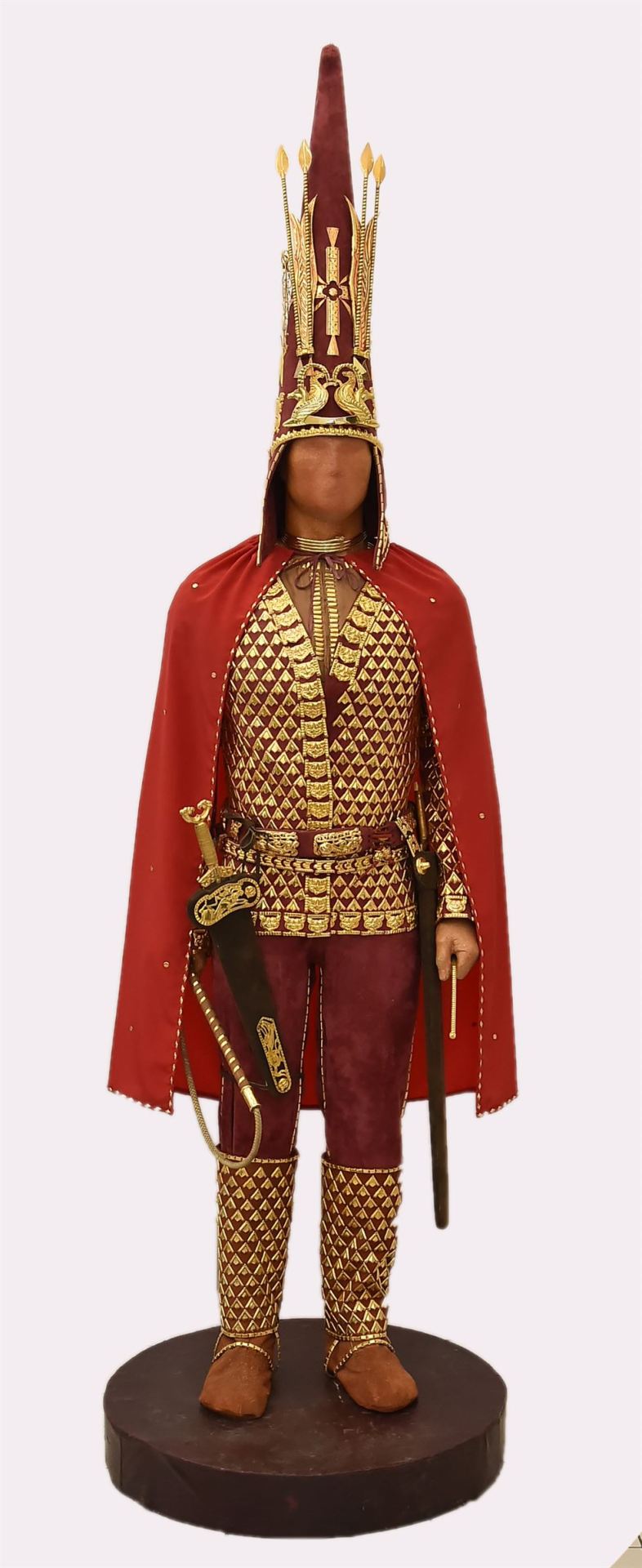
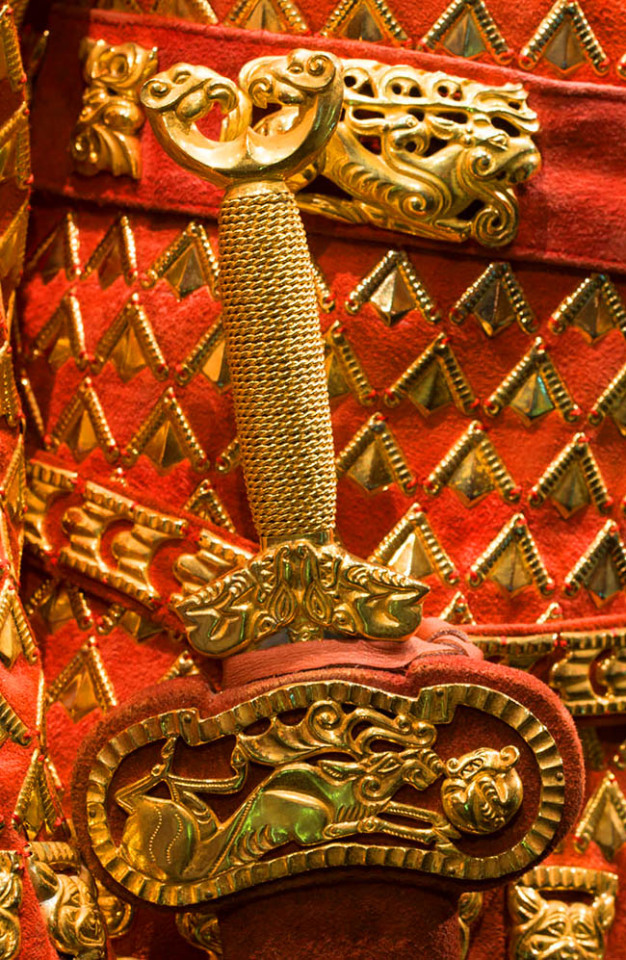
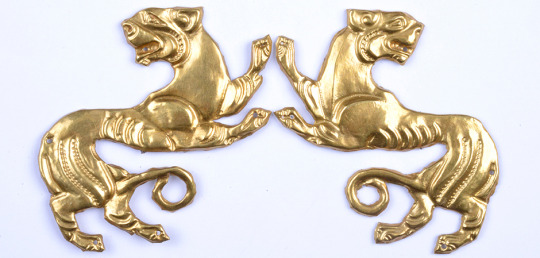

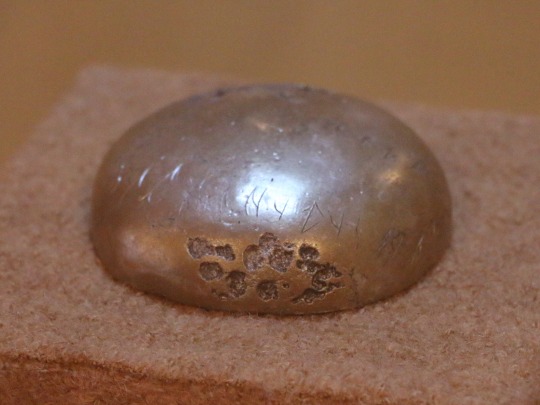



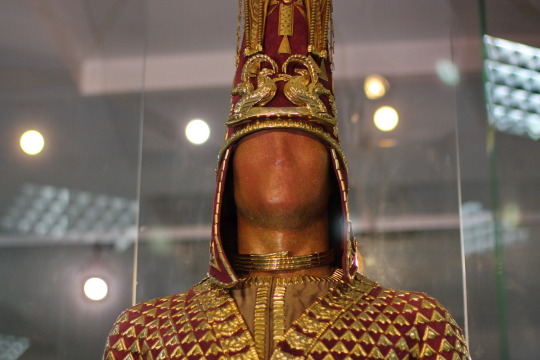
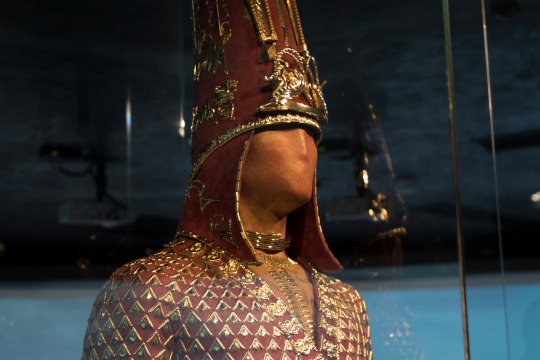


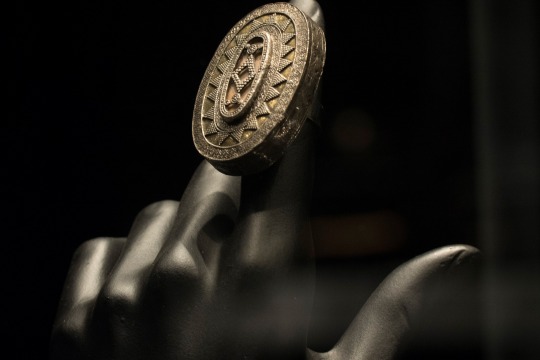

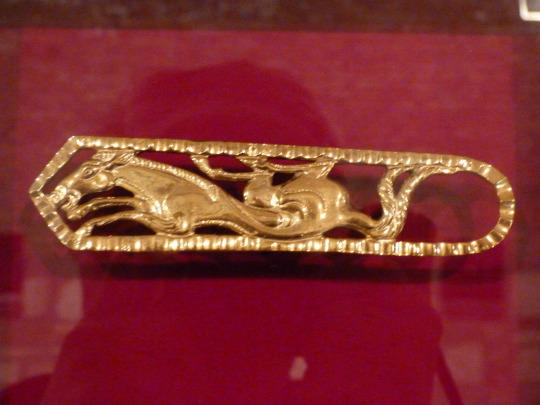
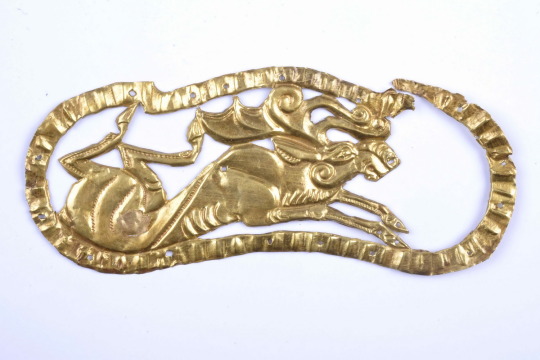
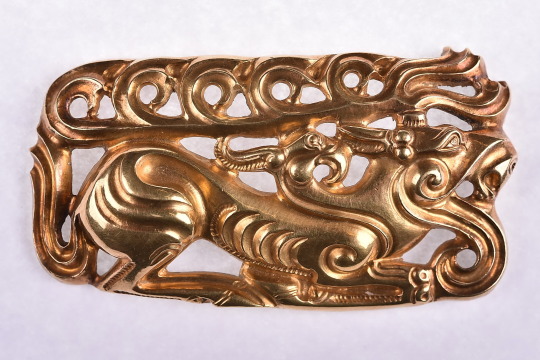

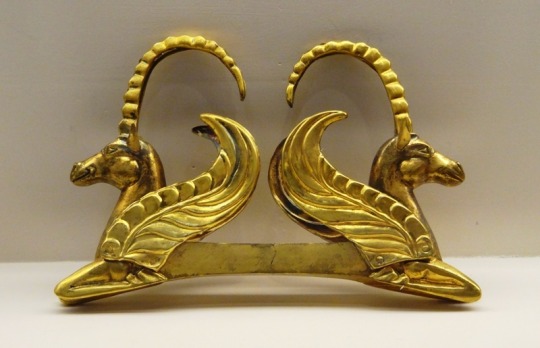
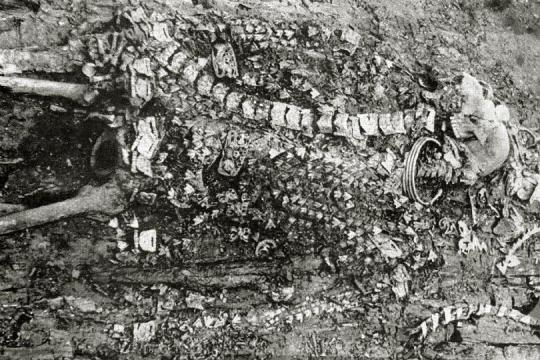



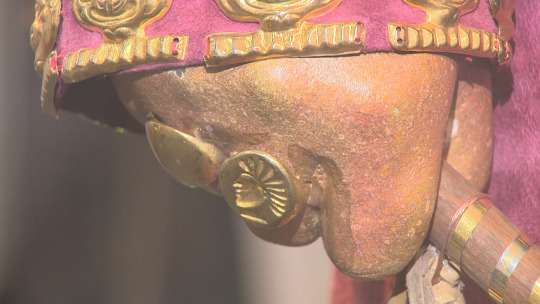

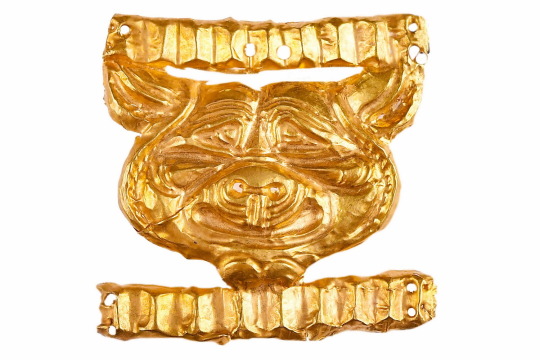

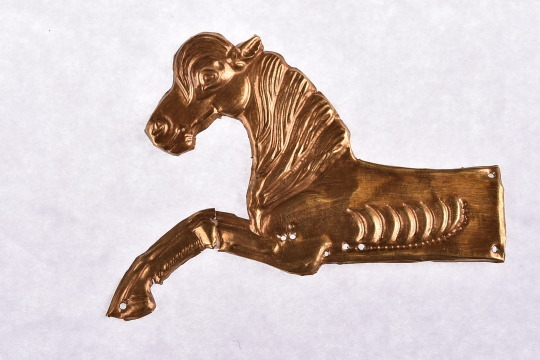

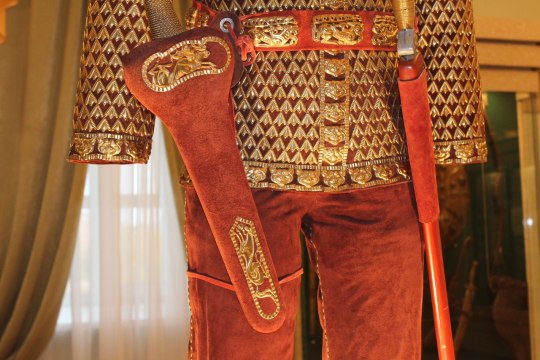
The Issyk kurgan of the 'Golden Man' 6th-3rd C. BCE
"The Issyk kurgan, in south-eastern Kazakhstan, less than 20 km east from the Talgar alluvial fan, near Issyk, is a burial mound discovered in 1969. It has a height of six meters and a circumference of sixty meters. It is dated to the 4th or 3rd century BC. A notable item is a silver cup bearing an inscription. The finds are on display in Nur-Sultan. It is associated with the Saka peoples.
The burial complex located on the left bank of the Issyk Mountain River, 50 kilometers to the East to the Almaty city. The unique archaeological complex found by a small group of Soviet scientists led by archaeologist Kemal Akishevich Akishev in 1969. The burial ground consists of 45 large Royal mounds with a diameter of 30 to 90 and a height of 4 to 15 meters. The Issyk barrow is located in the Western half of the burial ground. Its diameter is 60 meters and its height is 6 meters.
Situated in eastern Scythia just north of Sogdiana, the kurgan contained a skeleton, warrior's equipment, and assorted funerary goods, including 4,000 gold ornaments. Although the sex of the skeleton is uncertain, it may have been an 18-year-old Saka (Scythian) prince or princess.
The richness of the burial items led the skeleton to be dubbed the "golden man" or "golden princess", with the "golden man" subsequently being adopted as one of the symbols of modern Kazakhstan. A likeness crowns the Independence Monument on the central square of Almaty. Its depiction may also be found on the Presidential Standard of Nursultan Nazarbayev.
There were two burials in the grave complex: the Central one and the Southern one (to one side). Unfortunately the Central burial site had been robbed but the side grave was undisturbed. The burial chamber in the side grave was constructed from spruce logs. The tomb and its contents remained intact and buried. The skeletal remains were found in the Northern half of the chamber. More than 4,000 gold items were found in the chamber, as well as iron sword and dagger, a bronze mirror, vessels made of clay, metal and wood, shoes, headdresses, gold rings, statuettes, bronze and gold weapons, and an inscribed silver bowl dating from the 6th to 5th century BCE. Many clothing ornaments made of gold, a headdress and shoes were found on and under the remains. Next to the remains were an arrow with a gold tip, a whip (the handle of which was wrapped with a wide ribbon of gold in a spiral pattern) and a bag containing a bronze mirror and red paint. Scientific research, particular that of the anthropologist O. I. Ismagulov, shows that the remains belong to a member of the Saka peoples of Semirecheye, who have a European appearance with an admixture of Mongoloid features. The age of the body at death is estimated at 16–18 years, and its sex is indeterminate. The form of clothing and method of burial suggest that "The Golden Man" was a descendant of a prominent Saks tribe leader, or a member of the Royal family.
A text was found on a silver bowl in Issyk kurgan, dated approximately VI BC. The context of the burial gifts indicates that it may belong to Saka tribes.
The Issyk inscription is not yet certainly deciphered, and is probably in a Scythian dialect, constituting one of very few autochthonous epigraphic traces of that language. János Harmatta, using the Kharoṣṭhī script, identified the language as a Khotanese Saka dialect spoken by the Kushans.
The Wikipedia page has a possible (partial?) deciphering of the Issyk inscription as: "The vessel should hold wine of grapes, added cooked food, so much, to the mortal, then added cooked fresh butter on".
...
Kazakhstan will rebury an iconic ancient warrior in a time capsule this year (2019), in the hope that future generations will be able to establish who he really was, Kazakh TV reports.
Since independence in 1991, he has become a symbol of Kazakhstan's national heritage. His armour takes pride of place in the national museum in Astana, and tours the world as a calling card of Kazakh culture.
The bones were only rediscovered recently at a forensic institute, stored in a cardboard box with a scribbled note reading "The Golden Man, May He Rest in Peace".
"We know his age and social status, while DNA tests could provide us with exhaustive data," researcher Dosym Zikiriya told Kazakh TV.
But Yermek Zhasybayev of the Issyk Museum held out little hope of this. "The bones are in a bad state. They have been kept in a cardboard box for 50 years and been exposed to all sorts of bacteria and viruses, including modern ones. It is now impossible to get a full DNA transcription - if only we had the skull, or just one tooth," he told the TV channel.
Scientists say their only hope is to seal the remains in a special time capsule to prevent any further decomposition, so that technological advances might allow future generations to glean more information about the long-dead warrior.
In recognition of the Golden Man's status, the capsule will be "ceremonially buried in keeping with ancient royal traditions", Kazakh TV said.
Archaeologists are confident that the remains date back to at least the 2nd-3rd century BCE, when south-eastern Kazakhstan was home to the Saka people, who are believed to have been part of the broader Scythian nomadic confederation.
They were gradually displaced by the arrival of the Kipchak Turk ancestors of the Kazakhs, but modern Kazakhstan has taken the Golden Man to its heart."
-taken from wikipedia and bbc
#saka#scythian#scythian gold#archaeology#anthropology#history#ancient history#antiquities#antiquity#artifacts#museums#ancient jewelry#pagan#6th century bce#3rd century bce
225 notes
·
View notes
Text
One of the easiest ways you can remember the date when the capital of Kazakhstan was moved from Almaty from Astana is to remember that Bäiterek

is exactly 97 meters tall, which corresponds to the year 1997 when the said event happened.
Also, inside the golden egg on the top you can find a golden plate with a deep imprint of Nursultan Nazarbayev's hand. You can put your hand there.
9 notes
·
View notes
Photo

Dramatic Place Names in Central Asia
Notes The same word translated as "terrible in Ivan the Terrible, closer to "formidable or "awe inspiring" than the modern connotation of the word "terrible. ** Renamed from Astana in 2019 in honor of former president Nursurtan Nazarbayev # Renamed after the self-bestowed • title of former president Saparmurat Niyazov A Supposedly named after the tendency of Indian slaves to die when being transported across the mountains. Etymology disputed, name afternativly means the more mudane Indian Frontier
by u/Aofen
128 notes
·
View notes
Text
Why domestic violence (against women primarily) is a big concern in Kazakhstan right now.
I haven't seen a good informal roundup so I'm going to take a stab at one. As always, do not entirely trust your ignorant American narrator.
It's not that domestic violence hasn't been on people's radars previously–y'all might recall that way back in 2019 Ninety One took part in a campaign against gender-based violence led by the US Consulate General in Almaty–and there are a good number of grassroots organizations that I know nothing about and can't do justice to. (A coalition of 16 of them, the Union of Crisis Centers in Kazakhstan, gets mentioned in this 2019 Human Rights Watch piece.) But it seems to have exploded in the last week or so as a result of several high-profile cases.
Quite possibly the biggest, and ugliest, one is the murder of Saltanat Nukenova; her husband, Kuandyk Bishimbayev, has apparently been ordered to jail as the suspected killer. I think this case is getting a lot of attention because Bishimbayev was a well-known figure who was in government at 27 and who is now suspected of corruption (apparently his father was buddy-buddy with Nursultan Nazarbayev; the top article on Orda.kz right now is an article raising questions about his mother's wealth) and because he was rich (see previous clause; also, the argument that may have led to him beating Nukenova to death apparently started at their restaurant); but friends of Nukenova's are coming forward saying that Bishimbayev had been physically abusing her for years.
I say "several cases" because the translated introduction to the latest Zamandas podcast refers to three separate cases, but I only know of the Nukenova murder. Suffice to say it seems to be the tip of a longstanding, widely-known iceberg. Here's the translation of a Facebook post by Zhanna Muhmadi, whom Eurasianet describes as a "well-known lawyer":
I would like to remind you that in Kazakhstan they give a WARNING for intentional beating of wives!
You beat her once, you get a warning, but the second time you can kill her.
In our country, even for the murder of wives they gave 1.5 years.
P.S. Sincere condolences to the girl's family. The most severe punishment for all murderers!
(Note that Google Translate rendered "You beat her..." as "You beat him," but I changed it; I suspect Russian has the same direct object for male and female third person.)
I've found translating timestamps useful in the past, so here they are for the most recent Zamandas podcast linked above:
00:00 Start of the podcast. Why are we recording this issue and important issues of domestic violence.
03:11 Terrible news of the past week.
07:08 About justifying comments and impunity. About Bishimbayev.
09:07 About manipulation in the media and blogging sphere. About Rashev.
10:59 What is known at the moment?
12:40 About silence.
13:56 Why do men hate women in Kazakhstan?
18:49 About rape in Taldykorgan. [note: this is harder to find information about, but apparently a high-ranking police officer in Taldykorgan has been detained on suspicion of rape.]
20:46 About the law on domestic violence and the inaction of the police.
24:04 “If you don’t hear girls, listen to men”
28:30 Why are men silent?
33:36 About n*violence and emotional tyranny.
37:20 About the incident with the security guard at the nightclub.
42:02 About misogyny.
44:50 About traditions and non-violence.
47:48 “If someone raises a hand against you, leave”
50:20 About education.
54:15 We as a society cannot forgive such things.
56:20 The problem of domestic violence does not have a social portrait.
58:14 About divorce and conviction.
01:00:02 About romanticization in the media.
01:01:03 About tightening the law. See something - say something.
01:04:01 About the relationship of law enforcement agencies to victims.
01:07:07 About male solidarity.
01:08:03 About the incident on the train and the conductors.
01:10:06 About the Don’t Be Silent Foundation.
01:12:51 About the situation in bars and spiking.
01:16:55 Conclusion.
The "Don't Be Silent Foundation," by the way, is NeMolchi (Не Молчи = "do not be silent" in Russian); I don't know if they're taking donations.
ZaQ and Alem both linked (in Instagram Stories) to a petition (machine translation) currently circulating that's calling upon the Kazakhstani government to take domestic violence more seriously and create stronger criminal punishments for it. (Alem spoke in his stories before sharing the link; unfortunately, as usual, I can't tell you what he said. @ninetyonekz translated the stories: one, two, three.) Orda has an article about the petition (machine translation) that notes that it was originally created in 2021 and basically went ignored for two years. The more cynical among you might say that domestic violence is this week's Current Thing in Kazakhstan, and the guys do not want to be seen as lagging behind. To be fair, I think Veronika has been publicly and privately acknowledging these issues for much longer; she linked to the petition as well, as well as to Dr. Aigerim Turekulova, who recently wrote about the health risks to Kazakhstani women and girls from interpersonal violence. Backup dancer Diana also linked to it, and wrote (if the machine translation got her caption right) about how her ex-husband was physically abusive, and people told her not to bother reporting it to the authorities, it would be a waste of time.
I don't know if this is going to lead to longer-lasting change. I sure hope so, but there's a lot of competition for We Need to Do Something About This right now, both in Kazakhstan and globally (a week or two ago a bunch of people, including I believe all of Irina Kairatovna, were raising money to help residents of Gaza City, and we haven't even gotten to the ArcelorMittal mine disaster in Karaganda last month). Also I would put the odds of a backlash as high. But at least something is happening. And since I suspect most of my audience is either against domestic violence or pro learning about Kazakhstan, it seemed worth reporting.
9 notes
·
View notes